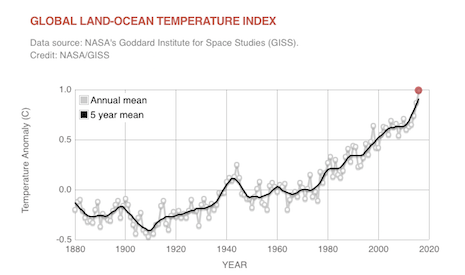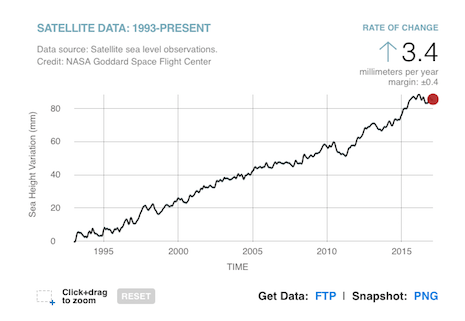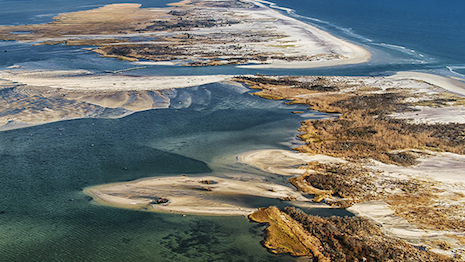Virtually all reputable studies of the Earth’s climate over the past few decades have shown that the temperature of the planet is changing at an alarmingly fast rate.
This is the consensus among climate scientists who have been desperately trying to get people to pay attention to this growing crisis for years. While luxury brands may think that climate change is something that will have a bigger effect on governments than on business sectors, the truth is that climate change can and will have a major impact on how luxury brands and manufacturers do business.
"Climate change affects every segment of the luxury industry," said Milton Pedraza, CEO of the Luxury Institute, New York. "Particularly and directly affected will be the luxury real estate industry where eroding shorelines can render many oceanfront properties around the world, both houses and buildings, worthless or useless."
The warming planet
With the advent of the industrial era, along with all the innovations and technologies that power our lives, has come a swift change in our climate.
Most climate scientists attribute this to the increase in fossil fuels burned and subsequently greenhouse gases released into the atmosphere, trapping heat in and warming the planet slowly but surely towards a dangerous level.
Some have countered these claims by pointing out that the climate has changed in the past, getting warmer and colder as part of a natural cycle. While this is true, the real problem with modern climate change is the rate at which our planet is warming, not the fact that the temperature is changing in general.
The long-term effects of climate change are still being mapped out by climate scientists around the world, but some of those effects have already been nailed down and they will impact the luxury industry in a major way.
The most obvious is that temperatures will increase. Colder areas will benefit in the short-term, increasing the length of time in which crops can be planted and harvested, which will be a benefit for luxury vineyards in colder areas.

Land temperature change since 1880. Source: NASA
On the other hand, this will mean droughts and heat waves throughout the world, significantly increasing the difficulty of manufacturing in warmer areas of the country. Factories need water for most product creation and workers cannot work in extreme heat.
Outside of just the heat will be the increase in sea level. NASA’s Global Climate Change organization projects that the global sea level will rise by one to four feet by 2100.
While four feet may seem like nothing, that increase could flood massive areas of low-lying or coastal regions around the world. This will have a devastating effect on South Asian countries where much manufacturing is done. The region is also an important emerging market for luxury brands in terms of retail, hospitality and local consumers traveling abroad to make high-end purchases.
Finally, NASA predicts that hurricanes and tropical storms will become both more erratic and more intense, meaning that not only will storms be stronger in general, but they will also be harder to predict.
This will wreak havoc not just on shipping lanes throughout the world’s oceans, making the transportation of valuable materials more difficult, but it will also affect cruises and travel.
"The resort industry, which is a large segment of luxury, is similarly affected," Mr. Pedraza said. "And all types of travel such as cruise lines and yachting can be disrupted by harsh weather patterns."
Renewable energy
Now that the connection between climate change and the future of luxury has been established, what can be done about it?
There are two levels that luxury brands can approach climate change on: the micro and the macro, or the personal and the global.
Luxury brands first and foremost need to get their own houses in order, cutting dependence on fossil fuels and moving as much as possible to using renewable energy sources.
Additionally, luxury brands can review their business practices and cut out as much waste creation and pollutants as possible, as both can contribute to global climate change.
This alone can have a large impact on climate change’s effects.
On average, the supply chain accounts for half of the typical corporation’s carbon emissions, according to a 2016 report by French luxury conglomerate Kering and nonprofit consultancy BSR.
Climate change could have negative effects on the quality and availability of a number of raw materials, and the associated combative measures could also impact the fashion industry. To assure their own futures, brands in fashion must play a part in reducing emissions and combating climate change, building it into their long-term strategy (see story).
Wind and solar energy are both becoming more viable every day and the sooner luxury brands make the switch, the sooner they can move to the second step: the macro.

Sea level rise since 1995. Source: NASA
One luxury brand switching to renewable energy is great, but climate change cannot truly be circumvented without a concerted global effort.
Luxury brands are some of the biggest and most profitable in the world. They can use their money and influence to encourage other companies around the world to remodel their business practices to be less wasteful.
But relying on simple encouragement will not be enough, as there will always be brands and people that put short-term profit over long-term benefits for the planet.
For this, luxury brands can throw their weight behind international efforts to regulate fossil fuel emissions, offering incentives to switch to renewable energy and sanctions against those that continue to contribute to the warming of the planet.
LVMH spirits brands Hennessy and Moët & Chandon, for instance, have programs that confirm the conglomerate's conviction for fighting climate change.
At Hennessy, the cognac-maker started acquiring green vehicles and delivery trucks in 2011 and now operates the largest fleet of electric automobiles in any private business in France. Acknowledging that electric automobiles would cut CO2 emissions by 80 percent, Hennessy’s fleet is 80 percent Renault and BMW electric vehicles.
Likewise, Moët & Chandon took a electric view on production by adding a fourth T4E electric tractor to its fleet as a way to eliminate emissions and protect its vineyards. Designed by Champagne firm Kremer Energie, the T4E is the first tractor that is 100 percent electric (see story).
Looking at the data of climate change can be depressing. Although it sometimes seems the planet has been on a long slow decline with little progress being made, especially given United States President Donald Trump’s promise to pull the U.S. out of the Paris Climate Agreement, striking a major blow to one of the largest international attempts to fight climate change.
But there is still time and there are still things luxury brands can do to help stem the tide, so to speak. By switching to renewable energy and supporting efforts to convince others to do the same, the effects of climate change can be mitigated.
Members of the luxury industry need to do everything they can to change their own ways and to influence with whom they work.
"Luxury brands across all categories can switch to renewable energy sources such as wind and solar," Mr. Pedraza said. "They can also insist that suppliers also switch to renewable energy over time.
"Luxury can also use its charitable resources to support the switch to renewable energy by society at large, as well as help fund projects that provide renewable energy to those who cannot afford it globally," he said.
{"ct":"nDs5xL7RigCsAQOE0G\/d81C+BcEDFwEHyMVZKUWozj\/Wb23qjpEq6lsl7f+uF+zMnkexih8gNiLZq5dH6g8GSIXcarv0nJhXmHpY1osTL9CXMmz\/KUpcKHjnSGWWL6v0VFdWEkxvyOAHfyQRjqMP4mfMVU3W\/hOgtr+mopnOOBlGa5\/eafsWvq1DdnTePMN2QN7YNQCz743lXJY6JSxWDrdLn2kyOXLzeRK\/gH6x9Ag5MD+W4pXVze0himWiDfJUbBxYnIw3Ork4dxnik04JyY1e\/nt2tuSVoXvfN4dhD4ZbkqzuI7OvNTYGu1DfEqWhiKPgz1l+5jP6f2FOk8930CFB1aY87B9bg5mHZJFUj4cZjiS66jHRxb9E7y9UKaANwL0qQ95qT3fBPtu7McWVZyTAPteNuyCBzgGe5vPc8G0WNcFkzufme6fZturOjY\/k6cXRRAmdXNq6bpMsSsQe+r8XTPrlGOw6se8QzVGAwDrX\/f4JI213rPSmecz7\/VRBQSt0\/nNmvItsn61a5J04TeinPPGgL7\/cltENrHzZbwA9BW5NtFwzlKy1D9Vc7Z1PqwNFWVP6s3M80RCfQhQRbWRu3ap3czbBIVsN2mwcpuoyCQYODFHgvOed79iTDcazuwob+2pbsIL6Cz\/c2MtY05N1vU\/6e9fQeLLRzkWz+QVZnh1TDtVY12kyBt\/vzQffu7ITDKPc9LmjQ2y1NTRT4TBFj0AUUBcANrEW8ae6sMJRD99Ks8pjver0CnS8gYLx4BA2IVidLa1scYjVVxz0V49iFC\/gITuWYg6GacebsZnrRRUNAAnfG\/WtKlyh0WtUUkp3LbWO7hnvGupYKxGsad6JD0PsQQktFqUiS1zLoUYTEanMK1S+qcqUyyp4MMfPFRhfLtu3qUKaouuLVgW\/QH4fvpG7sxZ3XwS1Jzshec4nIQJ\/8ffPrLNSBsNe5wFiN2+NjBEj0v48QKokujAwPk7zjtxZ5Kga9Lx5tdtDEKPuoYuri5BxHzo\/cGtJwS9sS\/FRoMuwxMHs0lLHgU2GdcLlUWk22K++wDetJtCNadu57v4O8NlRr8eJKGk93XVds6y8V\/kkWJMsjvY3h6Yp\/m\/veJUXN4FOfinig1iBKwzYmtudadl3n93Z84EfD04tKnuoICWsaHzyw4oKwdY6QFO9uJ23WYzo1yqwEhafEzE2mMqDJmWRUJ6t5ik97oOhxSOAvGZz9VZE\/KZR8rMTo\/VHuB969eTbUd3OAyryOBm3R0Ok5HTHU5Lqprp8pjsvxqedvIxaIAOBZavIXwFNSXdrSH\/Si0l0SLlLqHe5JROM+YJ6c5cujd9WUWecVyJBV7B2VcJHVvHkzvquWxeTBYbAcwRKbqaw\/s63zXIHD7eylbbfF5Rg6Fxi4ghLvphwD0pv1rjpE0lHuG9wkhQFMsytzIzpu3fREdJ6K2vKLZ7+H0O7LLQ2AumabhBvZwo082WG1oZuoVlGmNk8a\/HZlHdbbVq8pR5OuIfO4db+QILOT8SIRYlyKYTnQGNTSNU7zBf+74fTQ7amDF89PGrboGGl35Sgj8YWUPIeLEGmBBJ7YWSICnRDeSuyvjRHcTh5OZe1WM6Gf+HCE0nT3mhd9QhOtdsmyLfe9rA7ssl\/qvY9vnXzHxGmkbGXGTfBnyMTICWsAYkZC2It5b7gO7DtbnePFwqS7Ydx4jocVIP7f+zgKwi4eZke6WyJYMEqdNptK61b\/LN8SMBe8sJty20wW7nTDMfHLpKA4m\/Pj954zjhnpSPqdAPVTgTsUqqUk8NxTNhl0BEHS5eAdMEEMQ420xyBoLVfJ3BeRwQcNAQYqFSZc6ufGLUuOPIfk6CQjb9aSS\/X92OIOVNkNM8dpsoxgv1sZkqWVSDqodE4xhoKzmuddbKWg+ALd7OZtvL9oOyQFn++rVeIHmfCOa1tWmlJ0BpCY2aIrfrflZww2Foi3ydxVXgDwOIf\/5xQJRbWgtoto7nAvxfCk1lMrZk+qdiovmymCN93tvH+XT0uelf4LGyw38Y82yYC8EloF9eDLNjPsVM14W1E9UsMpp2KXjUxp79trEitGEE4AFEEvkbtjfh3h6f7\/HFzfe5E4BxJsna5DBN20ixv1TL2J8NujJmygSryi7C2y64dMR8PDgmjFzszDzDMZ5T\/O7vSRuqluuzlQW2yg7n9y0d7WNieQZFSyKYemFGAyTVcMg\/6oh5h2GeMaRj9aEnv9R+Bnscpp5dmhw4BN8Hv18Wt1n1yCS2XhSruH\/1yiA2ceoF5OZMHv5x9pa4KTT8hfVKn3sFCgHLxKaoJ4CofHbsjVpeNAWQZSMO0ri7tALJGS+nKFQDXYQ\/63rLKQSPC0DNDz40usSttAsB+Ny1WFzGowTnTeUodS7ze2qeGSYOCthBkrqL3Ax057yLGCS8ECsij\/rXy1oa2mANBQ386EviNzrp8dCw3Wxp++LpQRNcnmlgFd0YC+eUvbfZxJ8mw4zOU2VgIzNkALLk71cWSjP2Lx16cAvNiTjcEvb6bI4Ri1O4Bl2TofXsZUTf2pR0OjMI17OXu+S03JUvRixOx\/PNCrtxhbAa2EWqakDQszhwvpYVrwov81yJ6pVxuCQ8FYQJuXdgyJ6mKwR17XJXiGSe88T+RNmuVMADC6i8mBTkvzXyqnDx+1dMV9YJzvEWQsmsnSB1N1PaPSPOC9UB7KWFMQvBqSl\/SXy\/uEW8ub1SwJg9SgeeG8noIrX1FRBZxeKbQ3i6x3aV8qZFM1f7NpZmfuAsgO2q+E+km\/vt6P5EFW9nbXhautLAQ0zumO1\/p\/d4M6P58uEl8KBp4RNI3L+zXea8hnM8Kq60FahdeqpfO2cTvASiNdhG3ir+6xAM1nnBCl+jbPVc0+JmKPIEjM\/wo+aCTaCelw7AO0M\/hI3IUshWFexivAwUmOAom8nvgheoT\/2do47dVE+Q6ZeIvmFJaSb3Vn+Rvnqn45lynPlhH2M8pgIXOAsN70zRkVuebAzFnz7NOHdTJ4TXLvcz3jIPFWFkEfLd\/kfzHdl6UVOlxq1zuCGO\/GajQJTUcMK3s\/eHTrqXVd4W7CoqqoY0p89OQabmE+tR2Xkr1nNO7aJ36ZDpqYudHRmc2umyA9H9csgL1Z\/4MUFqIOclGMburxixz2CEifRHNAOPogsD5Q7Z4LmHV1lYTpWqOfp95+f+19oZyR59Yier+rK29GnnznT\/xuNJhyCQuJgtV3cDpHqmqsZpaFpkhGeBwupUc1JXAWUVNitI1tre3HaVHBO\/W8Z0kC2Q9cy1VdVni2DqKIrmu69vhC+F8SfZGsvt+7t9ddzIlUf84a3XswwIZr6Er0GREalcLpJ+qz8\/pZOj+9hjM2vf\/4CtyDqwtuD8Q1phKcg6Vjr6cr6QRLEO7y7SZZqzVdkEBs21UFAfrrkXl0SN37PV4ck3yk3rYil4GKWmLQnaXzH+RF30+A4BmkOXzMgMYpprEil3su5lYEqNh+cbSK02Ix1tI\/D2N+IUIhXxD8DJfx4zLgszWBi2\/wuZiOXDaqdEWuOaX+4CO0APh\/G3oTB87IA0rVgSnJRv+7cZfFgu7e3QF3wLg9izaaWYwSst5S9cXqY48levSAWVubKTQ8p+jDx9hh4e28Eq3MFQRK6XSakoOTy2e9n6AXs1XdiW+8sXCCgGOhq+KKnUKn2mxXPHQ8tjZsb8sUNTprlfTj5H02WP00c3tZ1lsJWH5PHbjaihb2B9kiagod+GuOCaXIvrSpnZ\/FzICIuQvc8M8Hxm36hQdCvS3wp6sRmn2KuwvCRwNVV4u38aZIN4hNQqOiGfFGBDz6hbxzNkMwDTrQLCa1Knp5fdL+oVX4YwfIYj4cgRVI8rgCGmfG0Y4D\/gGApoRKlBdBVwPqT7HTg7BD2+LynAsiN\/9YghfHYjoLrfXI85YpO9sdeGZEDItcCsEir+tlnrdEo8Bl\/kY3fgx8exgWYw+Tt6+WeEMdqreCr3OfXWM1wuHadxMCuKm1YuXUXiJuUjmgJP3p8RtFmJLCXdYKBScuOao2hrglofgieIDS3\/4h6GQlKY4x+VimaIa0WcplqvSKg3bH78J5QkzdKBq3GVGtobOVbzTIKnsZ5IBa3YS8k6QOrp3vE+8S98qmENo1lTWehEGpsPDSPjVGrz4AzsfSY2iWqoO7XriJ1Yaxh0jx7OiZsQHX1kdQcnQ26FPIesF9Ivu7k2d6F6q+BQ3ZNM6Uac3w4k1B65U4Q0C+RpBeCZmz2TlTPw4t2EaON2Ij\/22DvlwuLlT2VXn5tHlJ9IOQZpGLIQ7Ac2IDvylH4zERM0smfeIyGFanZZc82gYiRIxGAH6SaqO4IfQ2a6YUUBI80a8ZWi+PJOQUb\/PkLjSiKeRNiUR9F1U4Q9r06zojN66ozl3T9GBijnIuajV0LMl5YQscR\/D+KgYENkYHwS1SyX32l1s3880wPPGP2pTd5vd1aiy\/bj5lgb+4iKGeLj7Dj+e7Ei1OGa8gFBvG15muflQYr9vMbXn1KBFmJk7W5wQd1dvS3zL4WAWy94TnQQFMXLBwfFDI8a4ec+QsPXZI9ZCtgPQDjpA3WpvYsQezXLGGYYhGo80b6RAUQPbCqLeaBv5z9y3BOiPQblafEIxWtoJ\/Xo9gTwPUgZAonAh8Qf9zXtP\/CExoHhPxWuAk1O+4JpSelsrlh0dcPAjETeLNKdcZE5T2RbBko4MGTz3LGUkT6WGeuH7OvxmVZT+2iA27wCSOyqHpH60LHL2e+4mJHlCHFbbY+GgOKs1r46BvSTSD7lWAz9gXesUxGvlDTXmdHXqHEt8wPMOJWeQAjQxYA1kX\/uWdm0wcBkcBTJieNc9wUR3o38WjS4Rf+cqRKf9M4AnTl6xiHIkuvk+04trvWmNK2y5XRlKWD36Z56ZFYJlmeW0j3r2Hf7Uy+21QvT\/CE69hYHQMl+aQorTTdxAABdi7Vd0QGOnIOZYgDgKa73+6Osf3GkXSUWxP0Z+YUmlKXHM51F1eDRdwCPIgG2Y9Fnl0DLIRo\/X1Px266ouKA5Znn457Jz+gd7BIQC40AINo27+Eoh\/hphdXhs5gy0k1+IAy4nNyWrmSOuxQqKIdJfVJEZpx1bf2JLSckiK31TzNnlmw9z3McXY7ke\/PlyjMvLEMc8lQMJk9tubYVPQMH8OGKteYpBkEwBD6D2EPKKjJLPv2MacztgOs6rmEy7ME+5jtMuLHHggxkFZH0a4wYLklL5a4tn7Pvq0ncXAgqMJs7dh3mDaxpx8qdXGkKZcbTFmlOdjk\/hFVfNffaOOSB87OZ9p+0Guim0jtB71If4LI1mzeUZLxpZVxrNqh9OykW62YGjrpz+qu6IdWfltV28NfIOTP0ia9iUexn8uvjExdCexQ3aQVqpxh+brqSph+ehVVLGRgZhjzZiS0xQR8hxE4q6bYNNXBT0NQ0+p3WR9GEeVEnSw870J945sKKbmNbc0XP+qeYT8tR8ys0CjYrNvt+4lRG6Z1lJJLtDQvOfNu8yIJFJzZFEHcZxkSO8hVooSvyJu5vrVUgmbFwNjJaXTSv+cQCWIqYBZj0PTa60yiRxAOK5B2yRSqY4i1AnM+U5OsFBHJ+93n+yP6oHS9R07JMMXHrY4+vIx26Oj+4z9sIt6tFMGG2poc\/Z83XVeSKNUyhLKxKkejMD0jHcRPpnaYv0s1ld1SNTPjiKDO\/YIqj5kpjUMsrgv6\/B3wbq5h5IKI\/KGZeLlCzorLYHBUCd4\/88jz7fKB07x8Lz8hp8qzFBOSu9IyvxBKNjdj6boOZJz5+vW9Ql2SmiEKQVpdltwT7xg\/WuT6KiiiSUGBrlNtZbgBqfPVKn8TWi7SmTIh57fU\/AiyHLX12eRuWVbIb0fRxmI35yKZN3KZCnSWJbMOocYsA\/kI2QxS+4MDcg7y0C\/kECfosrJMmOVC\/uJ4ZUIrnX\/C7mPNY5jCSP5zH4BI4O\/vM843WdG68QSOWjzkIQ7PK5S3t5dWg9M9eXMi3ZzD0LzSDHYJTS5uZIUZSKF43\/w2h974+CMiun+mpOP42Mv1CwN5oShjhO4mWGpXNwzdqUD6\/5XX\/ePhQIYjyRYHJOmQIsEgvSWbepoCRqBaxQf\/Cd1xWn5SJ4iKiWbzmJyfZZaGTcNR4tEjansay7ZCGloXX2YDr78OxXDMzPIDh52EEaQpo3cBLhQWPt34Ahg4k1RbCNyvmBIURPovxBLS1vWKGNgJkw5h44bUbJrILHLBM0kceTfom3CrQkdZuHeyUf9TiPovWKSQBrqbab3ujYS6YO3FbuaOn6iHX7y\/j4iUDRCeCZ7MppQhomyg3sfPlBAJL1ZLFtYPBkKDSfSrdPE0WJuRjFhv9NUiA4pim\/Rt94BKb8\/+EAxgYA6l39dqQbF6OaE5xzqawy7KcISEKotSyCdmBy3iWBC18xDVe09cvyem9M0J2WbUTuFM2mggSxnxYxW1VQq83Q2lFDSkZ2R6xudUgLYIrFN2cpSAiXztBXrQ+0vjpi0fU+zCtmbrc2oNU8hzds\/CIiUNNJDh0yYGfwc49RNWT0NfzUBPw2n4+bm7uyXJNaNL0nx6XriknTGz81TF2yt5vetvwtxyiRJmR6tnDIwGbV+sKHjc7cjJt+CW7PURFn0Wt3SId\/jpZwktDJIKfKHo8Q5ZguKqY3faLFzQ5JyJed0txzEqW8XnYqKdESMrrNkqFl7Yf6GbHGpUJ5Teu\/jW1Jjgz4Lj3fGkyPvESoOhsTYk8O\/jKvDAzpeOwBQKg5xCbr\/0kWY+lypotTb1CSQmRhDHw3y9z2Oa7Xdzx60y\/iPY+WEgJxor+lhkKBk+Fyp8\/3Dc2Hpvvmit1e6DWP7e9iWv0kerS+j0DSjkTYr3OScOf8heRNN40L5rFzn0FQehm034oU2MCd1lagVbcOQWzqwhCZO3JC\/h3cJmv4lwZtKUuB9b+AX+WFLMH8uZkN0tLl2ykDks\/dPqItkcka40SoIsuIwuQEA7+yZvcq1eTm9yumeZmNQTXLG\/jmr202uFUu3\/LOg1Ymt49igCh4KM5zeQYdgkin3BACZT+2sYSagzpcSWAJ0KlGZZu1nVywYPLxOqtEZVkG2VdHMx1EonWjDIcjYAbctMJ9uyLCCXhal4Z4Byc4JqXz5r0iIac+UtWfTaF3u3J6+qbsgOg58GuMBh5Uh2TH7WN4vUQ5olwENHa3D0bp5UvcR4Tw8pt0i3p0tPrsLbNABuwbaYqLsT1sp08V+34sZAXAajVtcEJgQau5tbS9OktWY0o4jcAhS9NEyUozDT1dYCNIFX9bJ9zLP1\/9m7Kb5rDU2WwG65vGulOmIBh1Nf0FDniy9kvVNUqVCXW2Aw7d\/wSGBuTPnjc7FavsrZnQIx30sgsqkgDOAdYxJNB9bW2qr7a3VRhCeOTUQA5RGSKGFG+jmbrOcjcw7rW\/BtiwDKlBUUh5Scv7h3tex2mP9ERDOysZD0Z\/RqiPwWM8S8ml4zEnLgQDGKf4yeMuFwyQhpVaU+8CagtOqwOa2UMHRzVtV9\/P82I\/5zXuJrmvE\/7fiWrZhpKhFczzKyZP1zzPcVHRpXHqrcps\/8rjsrkHAJR99JWcwuI0hnx1WRA3ISa5SBA5XcSuL7m4hQPho7elT7hB2dRaJRxJUbHj72mpPW4mXJQwGPnl\/U8gJ\/6uG1HnsedXOH1L6Iu3NhjuJzZ2gAzK9x9Nvw1HwcJ1ipC5iXTT2E9ZjB3PvAH5iCeR1euXO6iOrZxxnUyxy37Tf740PDI59kLGNBJLGoqE74B57HLiX9YxjXLdrhRrmztgljuJn10n7bQ\/tyWIgvtelXWfP4960e\/2uCn+xBP8yslzwub+lPH6AjBKXWI58t7T0LZE95V3GQ2vjSmjYvppie1vTsC\/8iumSQQvz\/NIS+q3MQTBpHx6Vq46pJXR77BMMvEbb0I137oICKKnBhcNcMU1amItjxA4X7twOP8TM1Vx2DHX\/46ckdSvrTAChZ3MsgivjOzxUTAv6n6DfCjSeq+gkd2ezR9ilNCg5y+ETFvKMOr8UG5duB3EfW4xyMeHpNgGPLYaz8tBOQ5eEcGkcCMNNYnD63TeNJpmy8bqV+YKUfmTBAWnlNQqkHeW7xHg4OZrtPsHOQ5aasrzYkfrP9IuzmJOu\/6D0MNcfwC4Rl3gf4YAbaMCxF1FQPYLDfL7SyHH7AJTf7KqHVmxKDPNMBICJaF4u8Nrb2rM8+WJMqCUEPdUAef\/KXM176dUIkRNX4Vkht3x7AokKCSVLjRvsuNWSliIapPfpSKTZmfqhKq3S4zFHOf2ehJxqAFPvX+PIAzpEG+GEN3NOBYRD+BQ9oclFi8njI68vbQmvNFViSk\/s\/KYjtlFzOljRn6QLwZYKTuYC+lL+EnzOijjw7ZiiA41YFMEf1KgkRPGz9DAnSCq0+c6Nxh+6gaAtuk7OUY\/umXcqti0E0O9PiFXHlDWtp5+GRxrRKt5nsZkPZjBdVPeCOf6x4TC7aUcP0AOhv+Yw5JwnRrIc0v6R8ozUJ0eT1cqZ1GJsmScMN92AFQWhIm9hN5zonR1+Sf4Ud\/n9H1mb3T3ERLPRJGsXXYTHNg59OakQy\/s9TLd1tYxGDyhr31lfG7od1ONVz8Dr2sDkaMZKoo73eB+8GEArTUwTIaAbKi9ocLizygH5NAX\/gCvo9nplqHp4pd9IiVJZ7sCeWwedgTzBAowxeb\/KplJsKRuqGoJaVKeKzRzMALGfjWpP89qIM4WH7zGzVbrnYPUoeSHo6Df6aIKUjBcQc6apt+DXHm4G5E3SuibKFZ\/ByBcOz6\/TuhmD0q7p7TN3gWwPvAtHK38uey1R\/V0gHE7vIW3fxLQ0B+LAUhRixhAj3RZO3GjOQaMyWri5XOp0OWUpmvNhlYQ3b4yTOKOC4uU1VNnNGIMK8m0fFWwOQixXZ21Aq6oZ3Spvpd\/ol+Bm7B0FW2eLQVcy7B+Lf2B7x6KlY8vifu\/hnomYlIiFymlJutDfCRHdiCDTyRrO8jIzzom0jrCBTCXY7NdDwlL3sQn3Sm3PlNMNFMEioPJz3WI\/s8\/k1iBxj9Cgedi8y2lR+h5Bvx\/L07z8uR1QpfMqQmNqgY7HtCVogeHNCm9C4uEEwsvIv3FgNRXQOmJiuthHgFFb3+vTPyWqEKKmz9UoxjoIJIA5MBDERXSZdGfZflj\/MAcQyepJ0KX60cWkglgv3isPb6FSm9bPrSxwk\/GnAcwX2QSLdzjEkjlYn38A0dC6jpT5gQ31jMlO4BFwtZLyyYOL8UwNV7d0anW7LhiGpszCbp+UFv3hb0Uss70yPsTqOBX4ORtAoRIcSFyDq0J0KjPsttvQOsFZOX2J97uQtS5apiZkV+RMETFf33\/SBZrQXszICpjkrR9IlY7Jb7ku6ULKTOTWmVwZnfwt6+7QzhK8ylmRLy5OrmBFSsJvJp8ZzUEHeuDA2jujU+Cvt6JFB1edjPAUj9RebnoFYACu38qMajxn3l4my3W23rRuOqkx2QOo4lsJAWPmybBY5XYqIoBD139kSClZUmBC1IBpZ\/vOky9f47WeAEHDMRTkcglntOqHOFqVTlDaPs0j8h\/0Sq7I\/qTba36Qzs5LNdjQ0HEw69MWYJyPVy8iscpLdTloMhQpQXbXltQ9xI4g\/+ywYnJaXKTBXUJEXt5J6C\/JN10nS4ITHquyOtQtt5VxvvU00X6zS0s3aDn8JLIocOrJP\/NOTBV\/50fTzTNNuIGgqk4qcueQFjzuzQ0Hskutf6VLmEw2sZKdcnw4sSIlI2IGh5SEmXvxiwIoJnj7Eh1mbpWN+je8uIhl75xrWD82yMkH3r1HXPN5WiIth6oMd0zIryRBw6147CxxGf9\/z7gfX8MZc4xaAB2uLp5yuedw9l4SEJCuiGGfJZBvmLsPF1pJ9QyHHKTKFdARfxF9Ow3IcSptc4mZDT3EQfPlg0lzIwqRsB5Q9Jixtb1M2JAPCYQgCI\/vcTsy6G1\/Cuzcgia5BeWwLnzZseOmyoYZ4UoLmZbAeQYhCIsbC9x\/ZEcrmXj4y79JUWs994ciyBtUjWTbTUCCFt3NIC94sXclp8J9R3THX2Ec3Vr5rBN6zkACBWF\/kjlDgSNwKyUTuBxzfRrf\/6psWg+1sryGUUNehAHApyCgSvRG3IoKbjPkJ6FjBkT6QuM4ZAsJDyRqUQScc\/j\/MffNAEDikUiUJ7Btk8fr+xdUrNwIlkfNXGt0PrQCu0\/Ukv6nidzH7JVHOoArME9\/hv04dyW\/xapDDWDtip8QQZhz9DxQ\/HVoJg\/re7BYDEIKothBFkbwrwNHzdPd4N6frLlnYSO2y86OyyRgiYELN7v3uWLo2i6Tfa7mFmtcjgG38sb\/r2eENgB+Dl0fWWV\/4mQMbD6Ofrxx0jIXH2Cl8XMRhiUTOGt6Y7p6TBpfnMh8Ja1G64UvQjqt\/oFY1fsx6JBRIr7d31pzsTmrJeeZNX0I0wRXKvdMxpDqC3HBxsLtGrJgG9Td4GAKbPbON0VjzYl0zszuep\/bZEyevvVuWE3FSZXNnkq7X5bdUiEAH++U2dI2Om96KPK9TmjVm63Qj04ZSnu5Fsb\/ZD+n\/Glr1lOoCiZIj\/v22GMWrNc4BeX1wDnS4K8l5vD9JUWDWWfX06Cd3e4ROjCoRu8a3+Kjm\/tQe9T6a3MuMf3CVm4uuERtz85yB8r8+gGycelf2E0YcswpCLRgkkbh7q63oBfsDRrynNbGqzli97l16xu0K53hBfhPQZDytqxonnzu9R43JQvVpjf6FkpFqvxc8ZdwzcZRUCdYpnnQZpKvF+zmsGqNHpLNGVuZUhUvC4LNqhhEq6K0\/OfRDpnRiiYupJXlqfCzWOlJNPHqx2Jv+POl+30vg8ZMBc5EYmKTpk0ePZ0+YK4nOCn1rHxS2EExWcwAX2s7bBJzebFl05Y+14OdgnnALlXbQxdEj3TtntpddDDCT4\/Rswv3BYedJMaCSzs3rx5uThw3EhzkW\/HZZCvR8LXNdWioN9EJmwDU3IoVdJldIt50xpEJFvZ6y9PrZyp\/YGlk691ntwXhd7u\/oUkDO0uAuNemK18zlGPARLPRWtlMpB5BrZCPjPfvZv63o5rH7PjtY2efRUQ3fYuL\/oZxL8L9sH2211FvoLo+\/dfD36uS\/WJnP\/hGuwxHcGA4TArnQLB8kudFk4YIu63HbErtoqYWs+bMRoEt0u4CLivuNQjDCsVf4yAE9D8uovESYgwcMLId8QcbaRomHoW+Y9wamD2MWqzICslrTYqKf7WNQKtz4Y0yQ\/qyWAWBWMn5R6fu+Lxe+tlQ1WblyKyVGMGzFKIhx+Oi29NAAmnFYQOlSh3ju+KzR09XrI4DQa3Cc3crhbA8WWxzOmtkTZa8Qichnpf8cSL0Da7oEg3sAdW7X\/UtzrXI4TPj6b7Dm+EzZb8rv96xnYpmj1tFmTJZO0OgACiPM6F0OJBUhr7oLClTJfxAQVYNacIqx4hy36u5ktToiDDqlkN+DdG5NRBELCZGmY8UvPKgxUPulvZSEkXWMnxGqKtHi8gmaI\/xGi+tRAAxqJsJ8enmh5WE+hgiQC7\/UMtbTKhv2f9ru0R6ENsAUw0srZDxfbS1XLw456rrEve2qYA+yNojiNvEAlv4vgGX8qbSqFeERzc7stzlJIgalkV7UzSGqArqsh2fXc1KyeJtDlbqK9OVUgZ6RKxJbrq5DyHqpm8c3wY3hMkChtMERhkttYkff6CW05td+r1onKE+z7h7bvKPxnJUBlXYS+quRQq3cskvs+vP420dGtQK3\/X5Oa\/U9oqHe5sEhocXIu3G3y0Lvx9\/FHPSmDt0gDtq6habKIDZCuNPt3k3zhsG935dpCpeYwRjVNErOcqreRVbSudZ\/b\/p55XXQVjqycSoWSilHOf7WjwAOvXUQsoBFQCGL45cUbX\/xAnQCRmmTk1GVDRMNgf3UxS4UuWrwncgKB+gFo+B7rt4yCx9mmp2eK08e4ll7tyGoO84lpFMew18kA\/tv7a5FuP+H80PATpGGzoIDHc17Ngl1gAht8O78SOSBi+cVtnUplRUTjozbO1b5rgwUbAeEab2C1hLGxi8\/LqV5kDBd42\/JHqyX8QyOepFMel17baxkSkfgSAsiqmVCF\/kNPowUlT4GMsYcUNoKRT0QZNvCLupu53MkvqWeOCRwSz32qZxrrEBOA7DZ7saGgJW9Ap2XTub5SZyWrPZ2CchyVigF2xxohrOBpDURAr17l88s5elg8NQXtTYIjztzcYU8+ktCx7EcXSxAjbQrRr5TOe4l\/UTxfpVJft0TO6DqpN+uu+v\/DgwOwXatsV78X2EWgoK4mWQIybPzSYRl\/L3nFqzg2fWrZCp1yKDA3XSzNe\/iMBMZNv0TLqDToEUi\/U+Gk3cMRSrqQV\/xrYdHwiXW3afgXo6BYfimgTlaWaWZB0MOHCMx9rof5H4jvSzZGbYJYMRSAQGFybwOGNC7ucLYL7RmQpYQ6CDdqv6YhKnRhOJjCupROEAYG4YMi1uCFm\/P3uathXv7g==","iv":"67b314add3c9a9eba7bdba0cbab02cbe","s":"df763a8ae934b334"}

 The Earth's temperature is rising, bringing deleterious effects to sea levels, coastal land regions and vital precipitation.
The Earth's temperature is rising, bringing deleterious effects to sea levels, coastal land regions and vital precipitation.